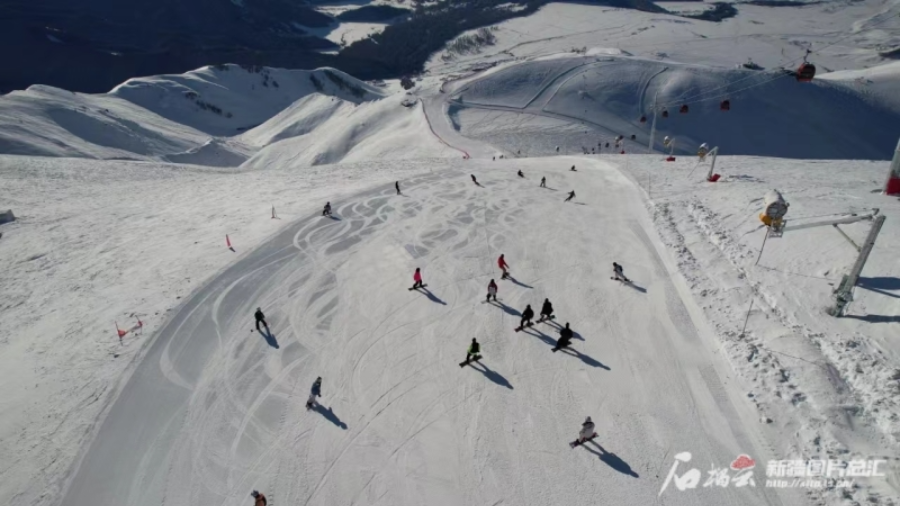Shiliuyun-Xinjiang Daily (Reporter Yao Gang) news: Boosted by the sustained strong demand in the tourism market and the robust impetus from the travel enthusiasm during the Spring Festival holiday, Xinjiang welcomed 41.01 million tourist visits from January to March this year, marking a 15.88 percent increase compared to the same period last year. The region achieved a tourism revenue of 43.74 billion yuan (about 6.1 billion U.S. dollars), a significant rise of 53.80 percent. With both volume and profit booming, the tourism market has achieved a strong start in the first quarter.

Photo taken on February 16, 2024 shows tourists ski at the Jikepulin International Ski Resort in Altay Prefecture, northwest China's Xinjiang Uygur Autonomous Region. (Photo by Wang Peng)
In the first quarter, Xinjiang's ice and snow resorts maintained the strong momentum from the fourth quarter of 2023 and continued to take the lead in various data metrics. The region's S-level ski resorts received about 2.49 million visitors, generating a tourism revenue of 303 million yuan (about 42.23 million U.S. dollars). Major ski resorts emerged as major attractions for tourist flow, for example, Jiangjunshan International Ski Resort received 712,200 visitors, Keketuohai International Ski Resort had 324,100 visitors, Jikepulin International Ski Resort welcomed 246,800 visitors, and Narat International Ski Resort saw 232,000 visitors.
Data indicates that visitors to Xinjiang's ice and snow resorts are mostly from southern provinces and cities in China, such as Fujian, Guangdong, Shanghai, Zhejiang, and Jiangsu. Activities like skiing, snow entertainment, and snow appreciation have become major choices for tourists to travel from the south to the north.
In response, various places in Xinjiang have launched timely initiatives, introducing unique tourism activities and products such as "Ice & Snow + Sports," "Ice & Snow + Hot Springs," "Ice & Snow + Chinese New Year’s Customs," and "Ice & Snow + Parent-Child" experiences. They have also launched 27 quality routes along with 158 premium winter and Chinese New Year travel routes, including ice and snow leisure, folk custom experiences, study tours, and rural health and wellness tourism, all of which have significantly boosted consumption in the ice and snow sector.

Photo taken on February 11, 2024 shows children are charmed by the Chinese chess in the experience area of an intangible cultural heritage exhibition for Chinese New Year’s customs at Xinjiang Museum in Urumqi City, northwest China's Xinjiang Uygur Autonomous Region. (Photo by Shiliuyun-Xinjiang Daily/Yao Gang)
Simultaneously, various places in Xinjiang launched a series of cultural and tourism activities and implemented a range of consumer-benefiting policies, distributing 5,320 "Xinjiang Tourism Digital Cards." The Sayram Lake scenic area in Bortala Mongolian Autonomous Prefecture introduced a range of discounts and services to visitors in winter, which included discounts on admission tickets, transportation passes, accommodations, dining, and skiing.
The Tianshan Tianchi scenic area in Changji Hui Autonomous Prefecture offered consumer-benefiting measures for skiing and ice skating, such as consumption deductions, discounts, distribution of coupons, and physical redemption vouchers. The Turpan Grape Valley scenic spot went online with a digital real-name ticket purchasing system, offering a lifetime free pass for the first real-name purchase, stimulating the potential for tourism consumption. According to statistics, the "Xinjiang Tourism Digital Card" cumulatively drove a transaction volume of 607 million yuan (about 84.6 million U.S. dollars), a year-on-year increase of 15 percent.
During the Spring Festival, the popularity of the leisure travel market within Xinjiang continued to rise. A total of 399 state-owned A-level tourist attractions launched free admission activities for the benefit of the public. The region received a cumulative total of 7.22 million tourists, an increase of 34.87 percent compared to 2023 on a comparable basis; the tourism revenue reached 7.39 billion yuan (about 1.03 billion U.S. dollars), an increase of 85.85 percent compared to 2023 on a comparable basis.

Photo taken on February 24, 2024 shows children make lanterns with their parents during the Lantern Festival fair at Xinjiang Art Museum in Urumqi City, northwest China's Xinjiang Uygur Autonomous Region. (Photo by Balligan)
The demand for cultural and leisure activities has led to the emergence of new formats, models, and offerings in the performance market. Dramas, children's plays, and situational plays are staged in succession, better meeting people's demand for high-quality cultural resources. In the first quarter of 2024, various places across Xinjiang held a total of 749 commercial performances, a 122.92 percent increase year-on-year; a total of 945 types of cultural and tourism activities were held, attracting popularity and driving visitor flow, further unleashing the vitality of the cultural and tourism market.
With the increasing number of China's visa-free countries, Xinjiang has also welcomed a peak in inbound tourism. According to the autonomous region's department of culture and tourism, in the first quarter of 2024, travel agencies within Xinjiang strengthened the development of tourism products for Central Asian countries. In collaboration with travel agencies outside Xinjiang, they launched a variety of premium Xinjiang tourism routes and self-driving tour products in Central Asia, launching wellness and study tours aimed at Central Asian tourists. A total of 869,100 inbound tourists were received, marking a 421.49 percent increase year-on-year; international tourism revenue reached 594 million U.S. dollars, a 353.77 percent increase compared to the same period last year.
(A written permission shall be obtained for reprinting, excerpting, copying and mirroring of the contents published on this website. Unauthorized aforementioned act shall be deemed an infringement, of which the actor shall be held accountable under the law.)









